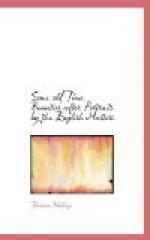“Go, and be guided by the
brightest eyes,
And to the softest hand thine aid
impart;
To trace the fair ideas as they
arise,
Warm from the purest, gentlest,
noblest heart.”
The third in that group of goddesses was surely the fairest of them all, of more perfect form, more noble bearing, having that ultimate element of the greatest beauty,—distinction. She came of a longer lineage, and was the consummate flower of beauty wrought by the sun and summers through many generations of patrician life,—life amid the palatial parks, the superb scenery, and majestic castles of England. Such living weaves its sweetest elements into the tissues of the being and works a spell of loveliness such as Lady Mary Somerset. She was the youngest daughter of Charles, fourth Duke of Beaufort, a descendant of the Plantagenets. In 1775, she was married to Lord Charles Manners, eldest son (born in 1754) of John,—that Marquis of Granby whom Junius attacked, who was associated in the government, in George the Second’s time, with the Earl of Chatham. The Marquis was a man of much force, and a most hospitable entertainer. He died before his father, the third Duke of Rutland.
Lord Charles succeeded to the dukedom in 1779. He had formed a friendship at Cambridge with Pitt, the son of his father’s colleague, and through his influence Pitt entered Parliament. In 1784, he was induced by the young premier to accept the Lord-Lieutenancy of Ireland, and it is with the lavish entertainment and high revelries at Dublin Castle that his name and that of his beautiful Duchess is connected.
High living soon told its tale, for the Duke died in 1787, at the early age of thirty-three. Though having the most beautiful wife in England, his affections wandered, and tales are told of his attachment to that siren singer, Mrs. Billington. The Duchess’s manner had somewhat of levity and much coquetry in it, though she could not be classed with that company who have not time to be virtuous. At the time of her lord’s death, she was living with her mother, the Dowager Duchess of Beaufort, in Berkeley Square, London, having been partially estranged from her husband. On hearing of his illness, she started to set out for Dublin; but a message of his death came fast upon the trail of the first news. Perchance it was this estrangement at death, this having parted in anger without the chance of reconciliation in life, that affected her so deeply that, though sought by many suitors, the widow was true to the memory of her late lord. Her son, John Henry, succeeded to the title; and his bride, a daughter of the Earl of Carlisle, was also known as a beauty, and her portrait was painted by Hoppner, in 1798. It was she of whom Greville wrote in his Memoirs, and commented on her lack of taste in spoiling the magnificent Castle of Belvoir, the pride and glory of the Eastern Midlands.
The beauty of the Duchess Mary Isabella was statuesque, classical; her features were noble. She received admiration as her right, but gave not largesse of smiles and wit in return. She was not as the Devonian divinity, “The woman in whose golden smile all life seems enchanted.”




